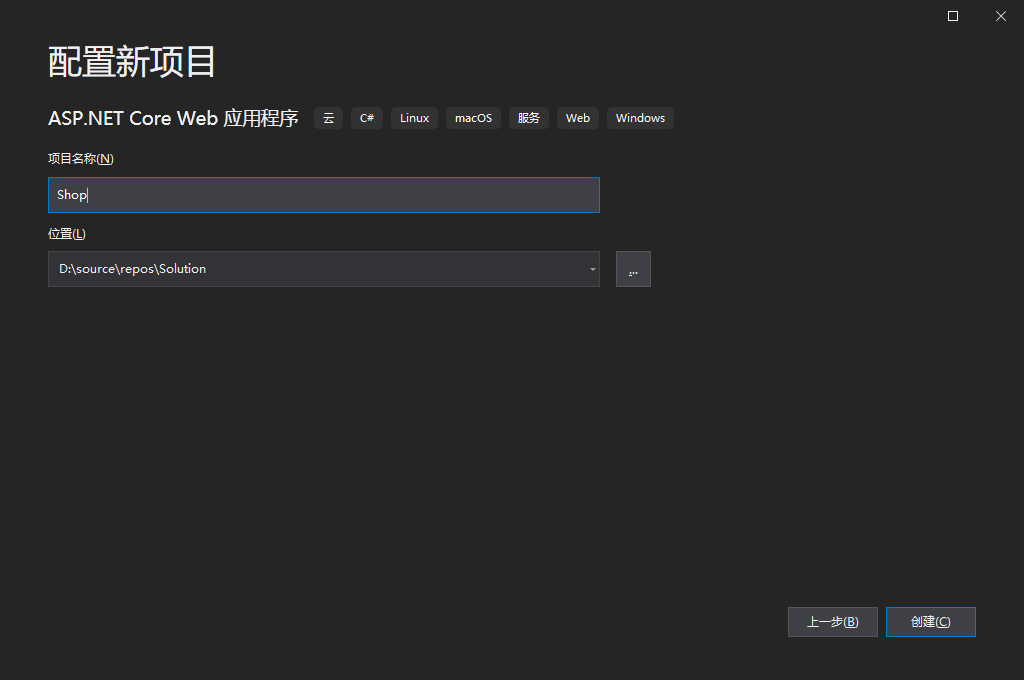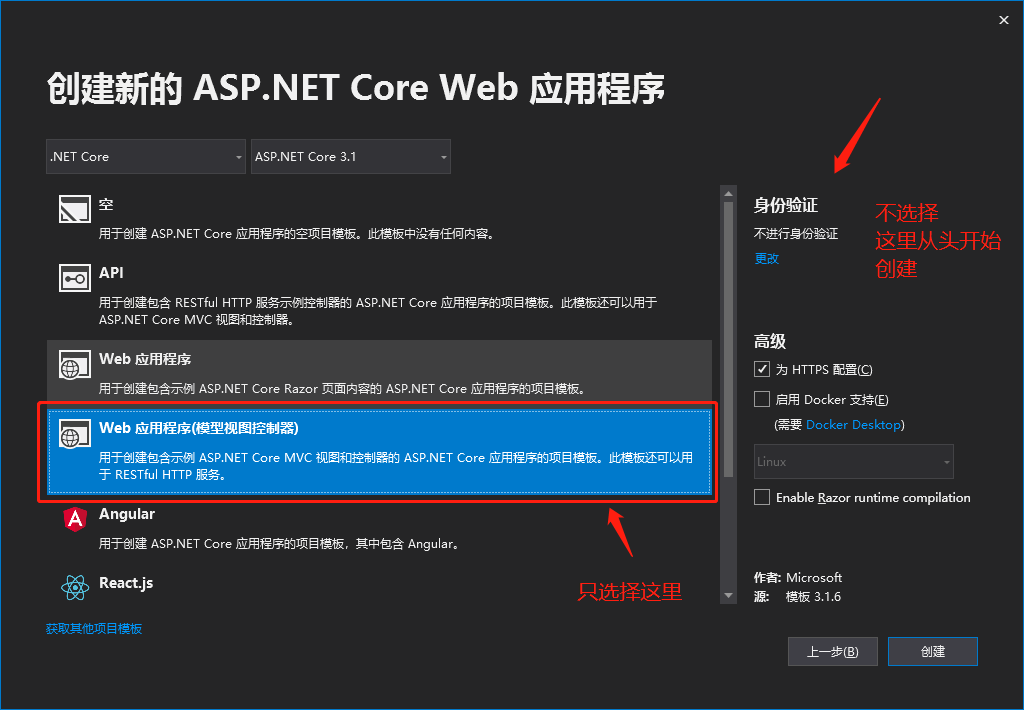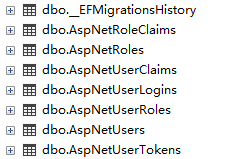理论知识微软官方文档最完整,最详细,这里只一步步的介绍如何使用,地址:https://docs.microsoft.com/zh-cn/aspnet/core/security/authentication/?view=aspnetcore-3.1
一、新建Mvc项目



二、加入EF依赖

浏览输入entityframeworkcore安装以下三项
Microsoft.EntityFrameworkCore
Microsoft.EntityFrameworkCore.SqlServer
Microsoft.EntityFrameworkCore.Tools

三、加入Identity依赖
同样方式将Identity依赖包加入
Microsoft.AspNetCore.Identity
Microsoft.AspNetCore.Identity.EntityFrameworkCore
Microsoft.AspNetCore.Identity.UI

四、创建DbContext
Models目录下创建ApplicationDbContext.cs类,代码如下,注意需要继承自IdentityDbContext
using Microsoft.AspNetCore.Identity.EntityFrameworkCore; using Microsoft.EntityFrameworkCore; namespace Shop.Models { public class ApplicationDbContext:IdentityDbContext { public ApplicationDbContext(DbContextOptions<ApplicationDbContext> options) : base(options) { } } }
五、修改Startup增加DbContext服务,
public void ConfigureServices(IServiceCollection services) { services.AddControllersWithViews(); services.AddDbContext<ApplicationDbContext>(options => options.UseSqlServer(Configuration.GetConnectionString("Default"))); services.AddDefaultIdentity<IdentityUser>(options => options.SignIn.RequireConfirmedAccount = true) .AddEntityFrameworkStores<ApplicationDbContext>(); }
六、增加Migrations并更新数据库,这里是从新建项目增加验证中复制过来的

00000000000000_CreateIdentitySchema.cs

using System; using Microsoft.EntityFrameworkCore.Metadata; using Microsoft.EntityFrameworkCore.Migrations; namespace WebApplication1.Data.Migrations { public partial class CreateIdentitySchema : Migration { protected override void Up(MigrationBuilder migrationBuilder) { migrationBuilder.CreateTable( name: "AspNetRoles", columns: table => new { Id = table.Column<string>(nullable: false), Name = table.Column<string>(maxLength: 256, nullable: true), NormalizedName = table.Column<string>(maxLength: 256, nullable: true), ConcurrencyStamp = table.Column<string>(nullable: true) }, constraints: table => { table.PrimaryKey("PK_AspNetRoles", x => x.Id); }); migrationBuilder.CreateTable( name: "AspNetUsers", columns: table => new { Id = table.Column<string>(nullable: false), UserName = table.Column<string>(maxLength: 256, nullable: true), NormalizedUserName = table.Column<string>(maxLength: 256, nullable: true), Email = table.Column<string>(maxLength: 256, nullable: true), NormalizedEmail = table.Column<string>(maxLength: 256, nullable: true), EmailConfirmed = table.Column<bool>(nullable: false), PasswordHash = table.Column<string>(nullable: true), SecurityStamp = table.Column<string>(nullable: true), ConcurrencyStamp = table.Column<string>(nullable: true), PhoneNumber = table.Column<string>(nullable: true), PhoneNumberConfirmed = table.Column<bool>(nullable: false), TwoFactorEnabled = table.Column<bool>(nullable: false), LockoutEnd = table.Column<DateTimeOffset>(nullable: true), LockoutEnabled = table.Column<bool>(nullable: false), AccessFailedCount = table.Column<int>(nullable: false) }, constraints: table => { table.PrimaryKey("PK_AspNetUsers", x => x.Id); }); migrationBuilder.CreateTable( name: "AspNetRoleClaims", columns: table => new { Id = table.Column<int>(nullable: false) .Annotation("SqlServer:ValueGenerationStrategy", SqlServerValueGenerationStrategy.IdentityColumn), RoleId = table.Column<string>(nullable: false), ClaimType = table.Column<string>(nullable: true), ClaimValue = table.Column<string>(nullable: true) }, constraints: table => { table.PrimaryKey("PK_AspNetRoleClaims", x => x.Id); table.ForeignKey( name: "FK_AspNetRoleClaims_AspNetRoles_RoleId", column: x => x.RoleId, principalTable: "AspNetRoles", principalColumn: "Id", onDelete: ReferentialAction.Cascade); }); migrationBuilder.CreateTable( name: "AspNetUserClaims", columns: table => new { Id = table.Column<int>(nullable: false) .Annotation("SqlServer:ValueGenerationStrategy", SqlServerValueGenerationStrategy.IdentityColumn), UserId = table.Column<string>(nullable: false), ClaimType = table.Column<string>(nullable: true), ClaimValue = table.Column<string>(nullable: true) }, constraints: table => { table.PrimaryKey("PK_AspNetUserClaims", x => x.Id); table.ForeignKey( name: "FK_AspNetUserClaims_AspNetUsers_UserId", column: x => x.UserId, principalTable: "AspNetUsers", principalColumn: "Id", onDelete: ReferentialAction.Cascade); }); migrationBuilder.CreateTable( name: "AspNetUserLogins", columns: table => new { LoginProvider = table.Column<string>(maxLength: 128, nullable: false), ProviderKey = table.Column<string>(maxLength: 128, nullable: false), ProviderDisplayName = table.Column<string>(nullable: true), UserId = table.Column<string>(nullable: false) }, constraints: table => { table.PrimaryKey("PK_AspNetUserLogins", x => new { x.LoginProvider, x.ProviderKey }); table.ForeignKey( name: "FK_AspNetUserLogins_AspNetUsers_UserId", column: x => x.UserId, principalTable: "AspNetUsers", principalColumn: "Id", onDelete: ReferentialAction.Cascade); }); migrationBuilder.CreateTable( name: "AspNetUserRoles", columns: table => new { UserId = table.Column<string>(nullable: false), RoleId = table.Column<string>(nullable: false) }, constraints: table => { table.PrimaryKey("PK_AspNetUserRoles", x => new { x.UserId, x.RoleId }); table.ForeignKey( name: "FK_AspNetUserRoles_AspNetRoles_RoleId", column: x => x.RoleId, principalTable: "AspNetRoles", principalColumn: "Id", onDelete: ReferentialAction.Cascade); table.ForeignKey( name: "FK_AspNetUserRoles_AspNetUsers_UserId", column: x => x.UserId, principalTable: "AspNetUsers", principalColumn: "Id", onDelete: ReferentialAction.Cascade); }); migrationBuilder.CreateTable( name: "AspNetUserTokens", columns: table => new { UserId = table.Column<string>(nullable: false), LoginProvider = table.Column<string>(maxLength: 128, nullable: false), Name = table.Column<string>(maxLength: 128, nullable: false), Value = table.Column<string>(nullable: true) }, constraints: table => { table.PrimaryKey("PK_AspNetUserTokens", x => new { x.UserId, x.LoginProvider, x.Name }); table.ForeignKey( name: "FK_AspNetUserTokens_AspNetUsers_UserId", column: x => x.UserId, principalTable: "AspNetUsers", principalColumn: "Id", onDelete: ReferentialAction.Cascade); }); migrationBuilder.CreateIndex( name: "IX_AspNetRoleClaims_RoleId", table: "AspNetRoleClaims", column: "RoleId"); migrationBuilder.CreateIndex( name: "RoleNameIndex", table: "AspNetRoles", column: "NormalizedName", unique: true, filter: "[NormalizedName] IS NOT NULL"); migrationBuilder.CreateIndex( name: "IX_AspNetUserClaims_UserId", table: "AspNetUserClaims", column: "UserId"); migrationBuilder.CreateIndex( name: "IX_AspNetUserLogins_UserId", table: "AspNetUserLogins", column: "UserId"); migrationBuilder.CreateIndex( name: "IX_AspNetUserRoles_RoleId", table: "AspNetUserRoles", column: "RoleId"); migrationBuilder.CreateIndex( name: "EmailIndex", table: "AspNetUsers", column: "NormalizedEmail"); migrationBuilder.CreateIndex( name: "UserNameIndex", table: "AspNetUsers", column: "NormalizedUserName", unique: true, filter: "[NormalizedUserName] IS NOT NULL"); } protected override void Down(MigrationBuilder migrationBuilder) { migrationBuilder.DropTable( name: "AspNetRoleClaims"); migrationBuilder.DropTable( name: "AspNetUserClaims"); migrationBuilder.DropTable( name: "AspNetUserLogins"); migrationBuilder.DropTable( name: "AspNetUserRoles"); migrationBuilder.DropTable( name: "AspNetUserTokens"); migrationBuilder.DropTable( name: "AspNetRoles"); migrationBuilder.DropTable( name: "AspNetUsers"); } } }
ApplicationDbContextModelSnapshot.cs

// <auto-generated /> using System; using Microsoft.EntityFrameworkCore; using Microsoft.EntityFrameworkCore.Infrastructure; using Microsoft.EntityFrameworkCore.Metadata; using Microsoft.EntityFrameworkCore.Storage.ValueConversion; using Shop.Models; namespace WebApplication1.Data.Migrations { [DbContext(typeof(ApplicationDbContext))] partial class ApplicationDbContextModelSnapshot : ModelSnapshot { protected override void BuildModel(ModelBuilder modelBuilder) { #pragma warning disable 612, 618 modelBuilder .HasAnnotation("ProductVersion", "3.0.0") .HasAnnotation("Relational:MaxIdentifierLength", 128) .HasAnnotation("SqlServer:ValueGenerationStrategy", SqlServerValueGenerationStrategy.IdentityColumn); modelBuilder.Entity("Microsoft.AspNetCore.Identity.IdentityRole", b => { b.Property<string>("Id") .HasColumnType("nvarchar(450)"); b.Property<string>("ConcurrencyStamp") .IsConcurrencyToken() .HasColumnType("nvarchar(max)"); b.Property<string>("Name") .HasColumnType("nvarchar(256)") .HasMaxLength(256); b.Property<string>("NormalizedName") .HasColumnType("nvarchar(256)") .HasMaxLength(256); b.HasKey("Id"); b.HasIndex("NormalizedName") .IsUnique() .HasName("RoleNameIndex") .HasFilter("[NormalizedName] IS NOT NULL"); b.ToTable("AspNetRoles"); }); modelBuilder.Entity("Microsoft.AspNetCore.Identity.IdentityRoleClaim<string>", b => { b.Property<int>("Id") .ValueGeneratedOnAdd() .HasColumnType("int") .HasAnnotation("SqlServer:ValueGenerationStrategy", SqlServerValueGenerationStrategy.IdentityColumn); b.Property<string>("ClaimType") .HasColumnType("nvarchar(max)"); b.Property<string>("ClaimValue") .HasColumnType("nvarchar(max)"); b.Property<string>("RoleId") .IsRequired() .HasColumnType("nvarchar(450)"); b.HasKey("Id"); b.HasIndex("RoleId"); b.ToTable("AspNetRoleClaims"); }); modelBuilder.Entity("Microsoft.AspNetCore.Identity.IdentityUser", b => { b.Property<string>("Id") .HasColumnType("nvarchar(450)"); b.Property<int>("AccessFailedCount") .HasColumnType("int"); b.Property<string>("ConcurrencyStamp") .IsConcurrencyToken() .HasColumnType("nvarchar(max)"); b.Property<string>("Email") .HasColumnType("nvarchar(256)") .HasMaxLength(256); b.Property<bool>("EmailConfirmed") .HasColumnType("bit"); b.Property<bool>("LockoutEnabled") .HasColumnType("bit"); b.Property<DateTimeOffset?>("LockoutEnd") .HasColumnType("datetimeoffset"); b.Property<string>("NormalizedEmail") .HasColumnType("nvarchar(256)") .HasMaxLength(256); b.Property<string>("NormalizedUserName") .HasColumnType("nvarchar(256)") .HasMaxLength(256); b.Property<string>("PasswordHash") .HasColumnType("nvarchar(max)"); b.Property<string>("PhoneNumber") .HasColumnType("nvarchar(max)"); b.Property<bool>("PhoneNumberConfirmed") .HasColumnType("bit"); b.Property<string>("SecurityStamp") .HasColumnType("nvarchar(max)"); b.Property<bool>("TwoFactorEnabled") .HasColumnType("bit"); b.Property<string>("UserName") .HasColumnType("nvarchar(256)") .HasMaxLength(256); b.HasKey("Id"); b.HasIndex("NormalizedEmail") .HasName("EmailIndex"); b.HasIndex("NormalizedUserName") .IsUnique() .HasName("UserNameIndex") .HasFilter("[NormalizedUserName] IS NOT NULL"); b.ToTable("AspNetUsers"); }); modelBuilder.Entity("Microsoft.AspNetCore.Identity.IdentityUserClaim<string>", b => { b.Property<int>("Id") .ValueGeneratedOnAdd() .HasColumnType("int") .HasAnnotation("SqlServer:ValueGenerationStrategy", SqlServerValueGenerationStrategy.IdentityColumn); b.Property<string>("ClaimType") .HasColumnType("nvarchar(max)"); b.Property<string>("ClaimValue") .HasColumnType("nvarchar(max)"); b.Property<string>("UserId") .IsRequired() .HasColumnType("nvarchar(450)"); b.HasKey("Id"); b.HasIndex("UserId"); b.ToTable("AspNetUserClaims"); }); modelBuilder.Entity("Microsoft.AspNetCore.Identity.IdentityUserLogin<string>", b => { b.Property<string>("LoginProvider") .HasColumnType("nvarchar(128)") .HasMaxLength(128); b.Property<string>("ProviderKey") .HasColumnType("nvarchar(128)") .HasMaxLength(128); b.Property<string>("ProviderDisplayName") .HasColumnType("nvarchar(max)"); b.Property<string>("UserId") .IsRequired() .HasColumnType("nvarchar(450)"); b.HasKey("LoginProvider", "ProviderKey"); b.HasIndex("UserId"); b.ToTable("AspNetUserLogins"); }); modelBuilder.Entity("Microsoft.AspNetCore.Identity.IdentityUserRole<string>", b => { b.Property<string>("UserId") .HasColumnType("nvarchar(450)"); b.Property<string>("RoleId") .HasColumnType("nvarchar(450)"); b.HasKey("UserId", "RoleId"); b.HasIndex("RoleId"); b.ToTable("AspNetUserRoles"); }); modelBuilder.Entity("Microsoft.AspNetCore.Identity.IdentityUserToken<string>", b => { b.Property<string>("UserId") .HasColumnType("nvarchar(450)"); b.Property<string>("LoginProvider") .HasColumnType("nvarchar(128)") .HasMaxLength(128); b.Property<string>("Name") .HasColumnType("nvarchar(128)") .HasMaxLength(128); b.Property<string>("Value") .HasColumnType("nvarchar(max)"); b.HasKey("UserId", "LoginProvider", "Name"); b.ToTable("AspNetUserTokens"); }); modelBuilder.Entity("Microsoft.AspNetCore.Identity.IdentityRoleClaim<string>", b => { b.HasOne("Microsoft.AspNetCore.Identity.IdentityRole", null) .WithMany() .HasForeignKey("RoleId") .OnDelete(DeleteBehavior.Cascade) .IsRequired(); }); modelBuilder.Entity("Microsoft.AspNetCore.Identity.IdentityUserClaim<string>", b => { b.HasOne("Microsoft.AspNetCore.Identity.IdentityUser", null) .WithMany() .HasForeignKey("UserId") .OnDelete(DeleteBehavior.Cascade) .IsRequired(); }); modelBuilder.Entity("Microsoft.AspNetCore.Identity.IdentityUserLogin<string>", b => { b.HasOne("Microsoft.AspNetCore.Identity.IdentityUser", null) .WithMany() .HasForeignKey("UserId") .OnDelete(DeleteBehavior.Cascade) .IsRequired(); }); modelBuilder.Entity("Microsoft.AspNetCore.Identity.IdentityUserRole<string>", b => { b.HasOne("Microsoft.AspNetCore.Identity.IdentityRole", null) .WithMany() .HasForeignKey("RoleId") .OnDelete(DeleteBehavior.Cascade) .IsRequired(); b.HasOne("Microsoft.AspNetCore.Identity.IdentityUser", null) .WithMany() .HasForeignKey("UserId") .OnDelete(DeleteBehavior.Cascade) .IsRequired(); }); modelBuilder.Entity("Microsoft.AspNetCore.Identity.IdentityUserToken<string>", b => { b.HasOne("Microsoft.AspNetCore.Identity.IdentityUser", null) .WithMany() .HasForeignKey("UserId") .OnDelete(DeleteBehavior.Cascade) .IsRequired(); }); #pragma warning restore 612, 618 } } }
PM> update-database
Build started...
Build succeeded.
Done.
复制到本项目后直接更新数据库,目前项目框架已经搭建好,数据库表如下

